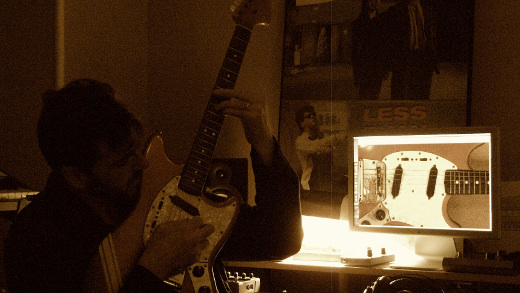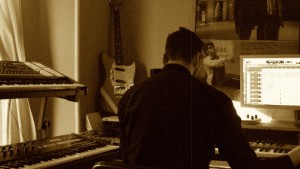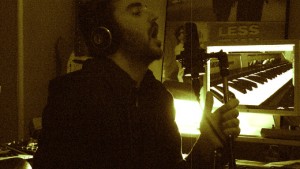“Sound Business”: Meet Pralaya Productions — Composing and Sound Design, Brooklyn
A magician never reveals his secrets – but fortunately some composers are more than happy to share.
Even though music-for-picture maven Matthew Filler is in the thick of boosting his new business, as you’ll see he’s got confidence aplenty in what makes him unique. That makes him the perfect subject for our new “Sound Business” series, where we take a closer look at startups, solo practices, multi-taskers, and other emerging enterprises within the industry.
For a big dose of the right attitude, and some can’t-miss tips on nailing the demo score for a TV commercial project, just keep on reading.
Business Name: Pralaya Productions LLC
Website: Pralayaproductions.com
Location: Brooklyn, NY
Launch Date: February 19, 2013
Revenue Streams: Pralaya composes original music and designs sound for TV, media, and film.
Clients/Credits: In recent months, I’ve worked very closely with the sonic branding firm Music and Strategy, a partner of Downtown Music, to compose, record, and produce songs for a multiplicity of commercial clients. This includes fashion, technology, alcohol, sports… you name it.
Prior to establishing Pralaya, I wrote music for an Emmy Award-winning sonic branding company called Audiobrain.
Ultimately, we work with anyone who needs original music or sound design for media, from advertising agencies to TV networks and independent production companies, to gaming companies, and so forth.
Key Personnel: Matthew Filler, Founder/Composer/Producer/Performer; Jennifer Filler, Performer; Chris Lehr (EVOL); Creative Direction/Artist/Designer
Unique Offering: Our strength is most definitely in the quality of our writing. Our experience is vast and unique, and the aggregate of that experience is what allows us to deliver music that is new and distinguished.
Basically, there are two things that I hear in music these days whether it’s from a television commercial or on the radio, and that’s music that either feels like a calculated assembly of sounds, or music that feels natural and social. If I feel that our material doesn’t have that latter quality, we set it aside and try again. If I’m not moving and connecting with the production while it’s happening, then how can I expect an audience to do so?
Pralaya also brings a passion for all types of music spanning several decades. We can do anything from modern pop, indie, and hip-hop to orchestral, jazz, and cinema; from the deep elusive corners of 1960’s European mod, to the contemporary pop fusion of artists like Miike Snow or Frank Ocean, but we’re always thinking about how to make it positively different, or how we might seamlessly blend elements of music from two different corners of the world separated by several decades to make something totally new.
Expansion Action: I have work, and lots of it. There are times when it’s hard to keep up. I am also continually making investments in the studio. Ultimately, there’s a long way to go, but we work very hard to be prepared for anything. This is certainly nothing to take for granted.
Case In Point: When I first starting doing this type of work, I didn’t have a process. The briefs would come along with song references, and I’d just glance at everything and start making music. Since then, things have changed profoundly. My process is never the same, but my preparation is generally very thorough no matter what.
The following is a breakdown of a recent project where I wrote some songs for a super-sexy shampoo / hair product commercial starring a famous actress / performer. (I have to be discrete because it’s still in the works.)
1. I received a brief asking for six or seven thirty-second tracks within 36 hours. The brief usually includes all sorts of details indicating the client’s desires, as well as a handful of reference tracks, additional language about the desirable elements of those tracks, and maybe a few different cuts of the commercial.
First, I printed the brief, read it through, went back, read and highlighted two or three times, and then taped it to the wall behind my monitor. There’s nothing worse than having to stop your creative process to open your email and double check something in the brief.
Also, the language in a brief can be really detailed, so read it several times and make notes. The way that a musician talks about music can be very different than the way an ad person does. So, you have to read carefully and interpret accurately.
2. Then I listened to the reference tracks. This particular client seemed to want something really close to the references, so I went the more analytical route on this one. I purchased and downloaded the tracks and imported them into my DAW along with the music-less video cut of the commercial. I lined up the 30 second commercial with different sections of the songs just to get a feel for what it is that the client likes about it.
This is the time to take notes about the reference tracks: instrumentation, tempos, progressions, cadences, structure, and things like that. What instrument is playing the theme? Are the drums acoustic? Electronic? Dry? Wet? Are those synth sounds derived more from the 70’s or the 80’s? I’m also going to place markers on the timeline for when things happen in the commercial. This way, I’ll know when to insert changes in the music to accompany the picture.
You can attain a lot of wisdom about what the client is trying to convey by understanding not only what the sounds are, but what’s behind the sounds, instrumentation, and production that comprise the reference tracks. It’s your job to identify the elements that sonically make up what they like, and mold them into something that they love. That’s why preparation and analysis are so important, because there are clues everywhere.
3. Then it is time to start composing. I typically will not labor over this. The first catchy melody, drum beat, or bass line that comes to mind, based off the brief of course, gets documented. Then I follow my notes from there and build the basis of the song. I’m always checking how it feels with the video and voiceover and tweaking things. Song structure and development are really dictated by the video unless the brief specifically says to not get to “scorey” with it.
This particular project was all about the electro-pop / dance, so the idea was to develop the beat over the first 10 seconds or so. Maybe we’ll start with an 808 kick for attack layered with something more organic for body? Bring in a dry mechanical hi-hat 2 bars later? Drop in the snare and bass somewhere odd for a surprising but impactful effect? Then we’ll get into the theme, maybe a delayed piano doubled with a glockenspiel that’s panned hard and low in the mix. Maybe we have a compressed synth pad that’s triggered by the kick? It really depends on what’s working for you.
This commercial had a big line in the voiceover at around :24 seconds. That’s where maybe everything cuts out but the kick drum for a bar or two before we come back in with a variation on the theme, perhaps a counter melody and/or an added sequencer for an intense re-entry.
This particular commercial was very colorful. There were also lots of hair flips and swaying hips. This is where I would add stings, glitter, electronic percussion, and other ear candy, just to give it that lift. I also might play with automating delays on some of that stuff so it pans in an interesting way, or maybe the delay is programmed to perform eighth notes on the left side and galloping triplets on the right? This is the fun stuff. Just be careful to be seamless and tasteful. Don’t overdue it and kill the pocket/vibe.
There are a million things you can do. This is just a rough sketch of my thinking for one particular track. You shouldn’t be afraid to experiment. Just make sure it’s all very cohesive and natural. For instance, lots of these sample banks are filled with really dark sounds. With this particular commercial, I had to be really careful to make sure the music sounded like “night time” music without it coming off too “dark.” One heavily reverbed-out synth could overly darken the vibe of an otherwise poppin’ track, and I’m not sure that the scene from Psycho would help to sell shampoo very well. Or who knows, maybe it would!
I think I wrote a couple of songs based specifically on each reference track for this one. Then, I did one or two that fused elements from the different reference tracks and took more risks. I’ll generally be conservative on some tracks and more liberal on the others. This is how I did it for this project because the brief was very specific. Just keep in mind that your not being asked to rip off these reference tracks. It’s a starting place. You’re ultimately supposed to deliver something that’s hopefully better!
4. After I finished writing and recording the 6 or 7 songs, I went to bed. Breaks are important in the audio world. With fresh ears I began to mix and tweak. It’s important to not get caught up with any major changes at this point. There’s a firm deadline, and that’s a rabbit hole. There are a lot of people depending on that deadline so they can go ahead and get their part of the work done.
5. After mixing, I’ll do a quick but effective mastering session. I am not a mastering engineer by any means, but certain production standards must be met if you want to be able to fairly compete with the other studios, so it’s good to have a basic knowledge and a means of doing so.
6. Then, I set up a session with the no-music cut of the commercial, lined up all the songs with the video until they were synched, got the levels right with the VO’s (you might have to use a little compression and EQ to get the relationship working), and bounced them to video.
7. Then, I sent the videos off along with MP3’s and/or WAVs. In general, I’ll also include any notes that I think might be helpful for when they have their client meetings and such. Most often, they’ll have an internal review of the work and ask for some minor revisions. Then the work goes to the client, notes are made, the field is narrowed, more revisions are done, you win the job, and all the production-related stuff starts happening.
Again, this is one of my experiences. It can be very different depending on the project.
Glowing Testimonials: This is a competitive world, and it’s always nice to hear some kind words from your client. Just this morning, a client thanked me for some recent tracks I provided saying that it’s some of the “best work I’ve represented in a very long time.” That makes it all worth it right there, especially when you know that this person is working with an amazing amount of new music everyday.
I also tend to get complimented on “going above and beyond” quite often because we often provide more music than is requested if we have time, and it’s nice that that’s recognized. Our “dependability” is often noted as well.
Why Being a Sonic Entrepreneur Rules: It rules because I love music, I hear new music everyday, I make new music everyday, I get better at what I do everyday, I learn everyday, I’m challenged everyday, and life will never be boring as long as I’m always in uncharted waters.
Why Some Days You Want to Pack It In and Get Your Real Estate License: I just don’t. I’ve tried to quit music in the past. Everything in life is difficult, but this is the kind of difficult you embrace.
The Ultimate Business Partner: David Bowie. Despite being a huge rock star, he always seemed to be a fantastic collaborator, always willing to experiment and try new things.
Sage Advice: Be patient. It takes time. You have to genuinely love the process. Don’t do it because you want to get somewhere. Do it because it’s where you want to be right now.
Also, you’ll receive more criticism than adoration. That’s just the nature of putting yourself out there. If you’re serious about what you do, you’ll put the non-constructive stuff out of your head immediately. It serves no purpose but to get in your way.
— Matthew Filler, Founder, Pralaya Productions
Please note: When you buy products through links on this page, we may earn an affiliate commission.











Kaya_Bailey
May 23, 2013 at 11:00 pm (12 years ago)This was a great look into his process and how they relate to getting sound for a brief completed.
Chelsea Richards
May 26, 2013 at 11:46 pm (12 years ago)Got to love the track you have here! Two thumbs up! It surely got me thinking when it goes ahead writing commercial tracks to be inventive to do the inverse of what the brand is doing now and giving them something else since its preferred to be completely wrong over just about right and to put yourself out there and be approachable with the intention that you are primed when a chance tags along.
Tocrres.com